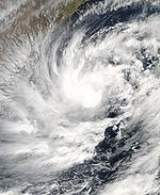
2003 North Indian Ocean cyclone season
Encyclopedia
The 2003 North Indian Ocean cyclone season had no bounds, but cyclones tend to form between April and December, with peaks in May and November. These dates conventionally delimit the period of each year when most tropical cyclones form in the northern Indian Ocean.
on the 19th.
on October 21. It tracked west-northwestward across the Malay Peninsula, ultimately hitting India as a minimal tropical storm.
. It tracked northwestward, slowly intensifying to a peak of 65 mph winds. It struck False Divi Point
, India
on the 15th at that intensity, and dissipated the next day. Rainfall from the storm caused the deaths of 27 people and damage of 5100 homes in India.
Season summary
Three tropical cyclones were observed, less than the average of 5-6. 1 reached Cyclone strength.Severe Cyclonic Storm (01B)
The first storm of the season developed from a broad surface trough on May 8 over the southern Bay of Bengal. It moved northwestward, where it reached tropical storm strength on the 10th. Mid-level ridging pushed the storm eastward, where after reaching a peak of 70 mph winds, upper level shear weakened it to a tropical depression. It managed to re-strengthen to a 50 mph tropical storm before hitting MyanmarMyanmar
Burma , officially the Republic of the Union of Myanmar , is a country in Southeast Asia. Burma is bordered by China on the northeast, Laos on the east, Thailand on the southeast, Bangladesh on the west, India on the northwest, the Bay of Bengal to the southwest, and the Andaman Sea on the south....
on the 19th.
Depression
The IMD classified one depression over the Bay of Bengal on June 21 that dissipated over Bangladesh on June 22.Deep Depression
The IMD classified one depression that formed on July 25, crossed West Bengal - Orissa coast near Baleshwar, and dissipated on July 26.Depression
This system was not classified as a tropical depression by the Joint Typhoon Warning Center, but was tracked as a depression by India Meteorological Department.- Best track for IMD tracked tropical depression http://www.typhoon2000.ph/garyp_mgtcs/oct03tks.txt
Deep Depression (23W)
A tropical depression formed in the Gulf of ThailandGulf of Thailand
The Gulf of Thailand , also known in to Malays as Teluk Siam literally meant Gulf of Siam, is a shallow arm of the South China Sea.-Geography:...
on October 21. It tracked west-northwestward across the Malay Peninsula, ultimately hitting India as a minimal tropical storm.
Severe Cyclonic Storm (02A)
On November 10, Tropical Depression 2A formed over the Arabian Sea. It moved west-southwestward where favorable conditions allowed it to strengthen, first to a tropical storm on the 12th then a hurricane on the 13th. Upper level winds caused it to dissipate on the 18th over the open waters.Severe Cyclonic Storm (03B)
The third and final tropical depression of the season developed on December 11 in the Bay of Bengal, a short distance northwest of SumatraSumatra
Sumatra is an island in western Indonesia, westernmost of the Sunda Islands. It is the largest island entirely in Indonesia , and the sixth largest island in the world at 473,481 km2 with a population of 50,365,538...
. It tracked northwestward, slowly intensifying to a peak of 65 mph winds. It struck False Divi Point
False Divi Point
False Divi Point is a low headland located at the northern end of the Coromandel Coast, in the state of Andhra Pradesh, India.It is located at the apex of the Krishna River delta. The area is low, swampy and dominated by mangroves.- See also :...
, India
India
India , officially the Republic of India , is a country in South Asia. It is the seventh-largest country by geographical area, the second-most populous country with over 1.2 billion people, and the most populous democracy in the world...
on the 15th at that intensity, and dissipated the next day. Rainfall from the storm caused the deaths of 27 people and damage of 5100 homes in India.
See also
- List of North Indian Ocean cyclone seasons
- List of notable tropical cyclones
- Tropical cycloneTropical cycloneA tropical cyclone is a storm system characterized by a large low-pressure center and numerous thunderstorms that produce strong winds and heavy rain. Tropical cyclones strengthen when water evaporated from the ocean is released as the saturated air rises, resulting in condensation of water vapor...
- Saffir-Simpson Hurricane ScaleSaffir-Simpson Hurricane ScaleThe Saffir–Simpson Hurricane Scale , or the Saffir–Simpson Hurricane Wind Scale , classifies hurricanes — Western Hemisphere tropical cyclones that exceed the intensities of tropical depressions and tropical storms — into five categories distinguished by the intensities of their sustained winds...
- 2003 Atlantic hurricane season2003 Atlantic hurricane seasonThe 2003 Atlantic hurricane season was an active Atlantic hurricane season with tropical activity before and after the official bounds of the season – the first such occurrence in 50 years. The season produced 21 tropical cyclones, of which 16 developed into named storms; seven...
- 2003 Pacific hurricane season2003 Pacific hurricane seasonThe 2003 Pacific hurricane season produced an unusually large number of tropical cyclones which affected Mexico. The most notable cyclones the year were Hurricanes Ignacio and Marty, which killed 2 and 12 people in Mexico, respectively, and were collectively responsible for about...
- 2003 Pacific typhoon season2003 Pacific typhoon seasonThe 2003 Pacific typhoon season has no official bounds; it ran year-round in 2003, but most tropical cyclones tend to form in the northwestern Pacific Ocean between May and November...
- 2003–04 Southern Hemisphere tropical cyclone season (disambiguation)

